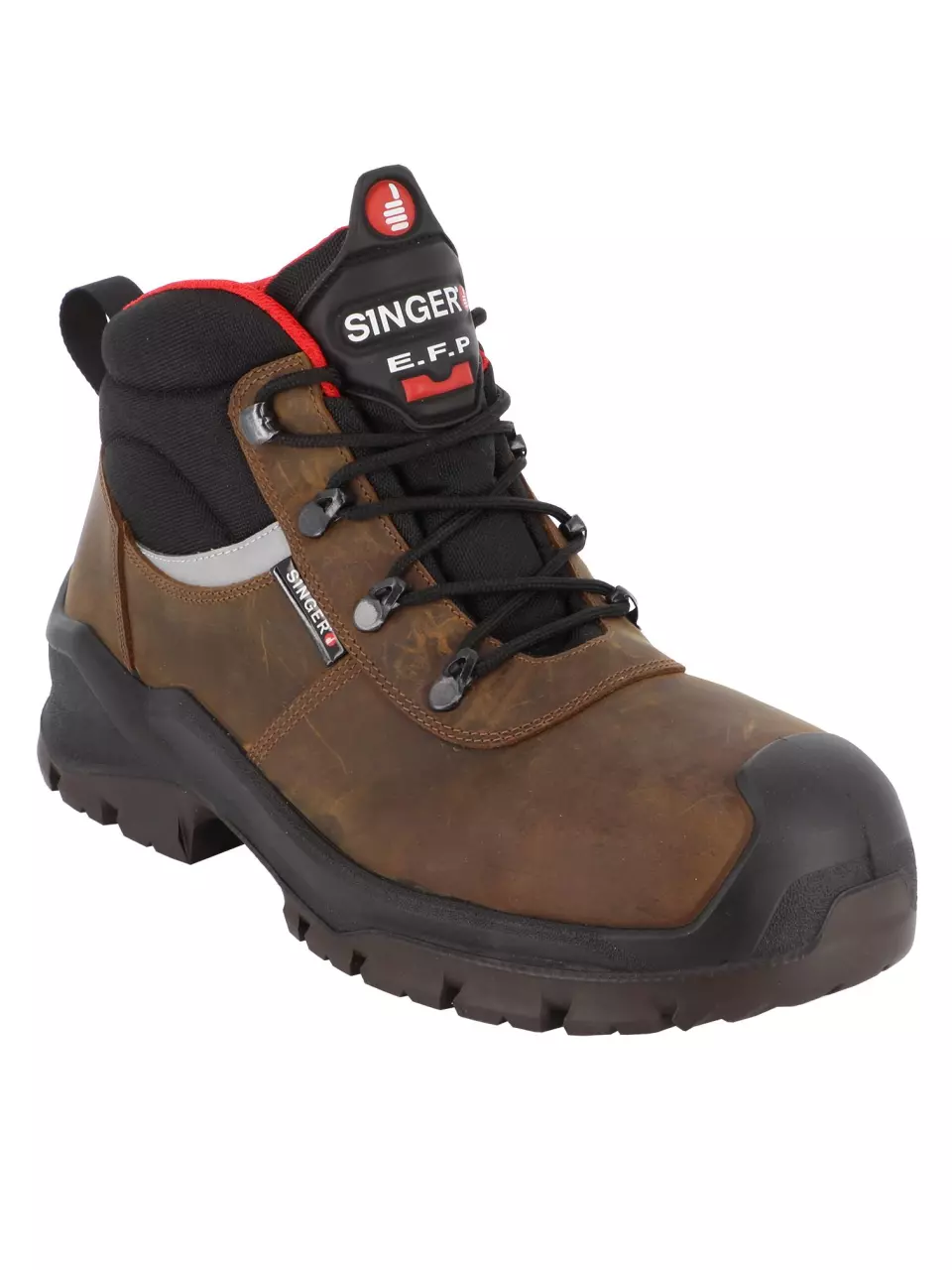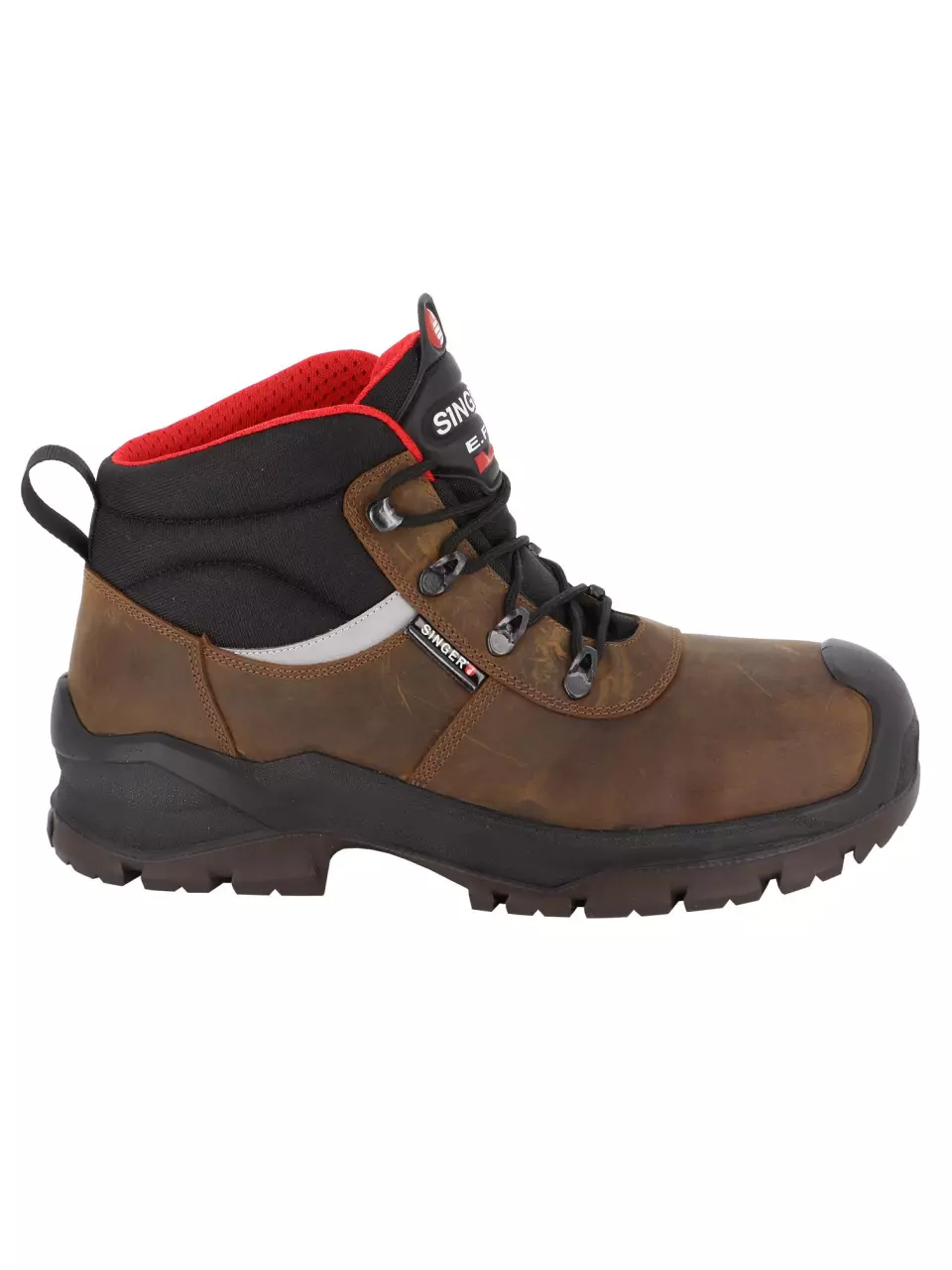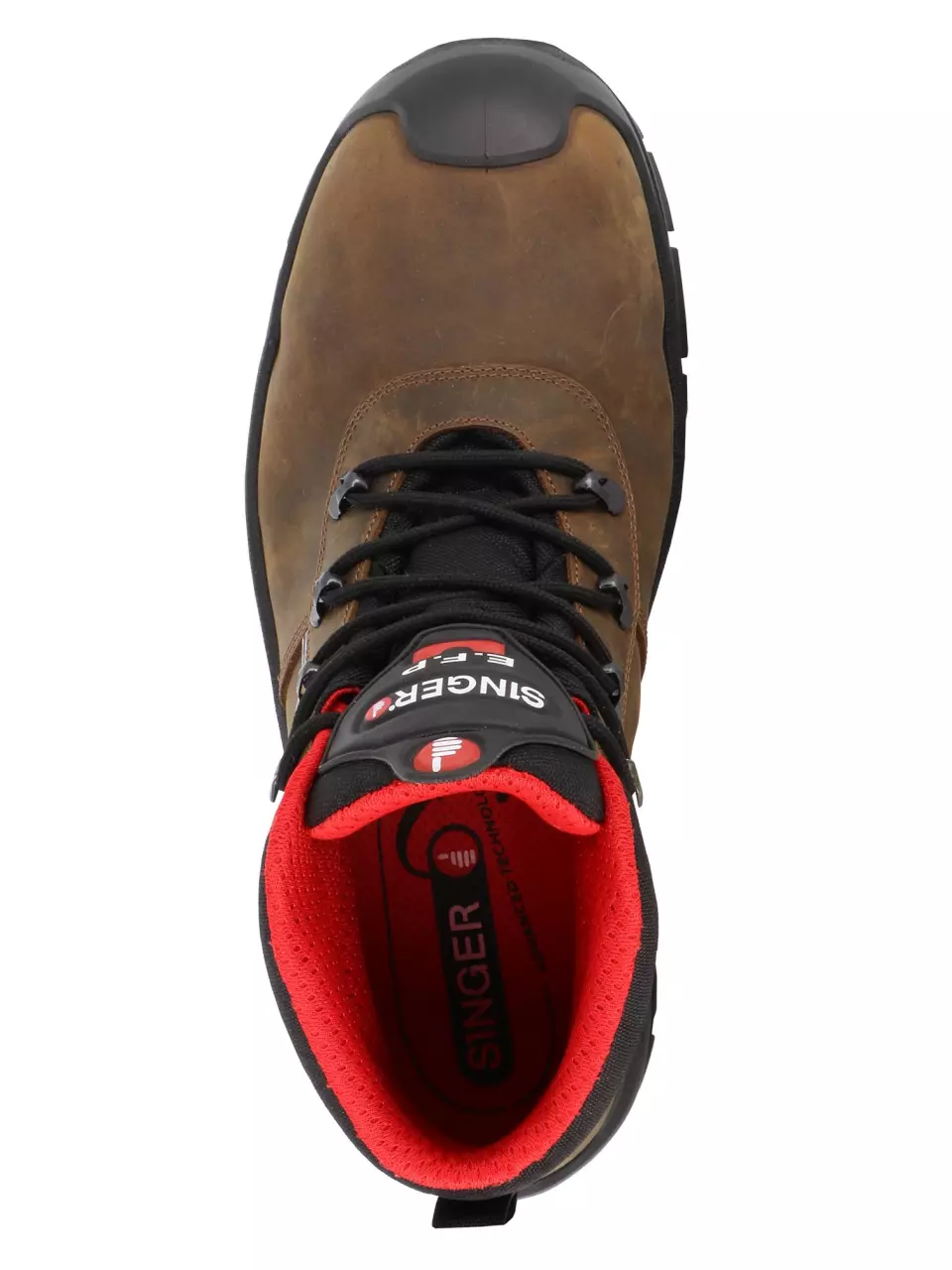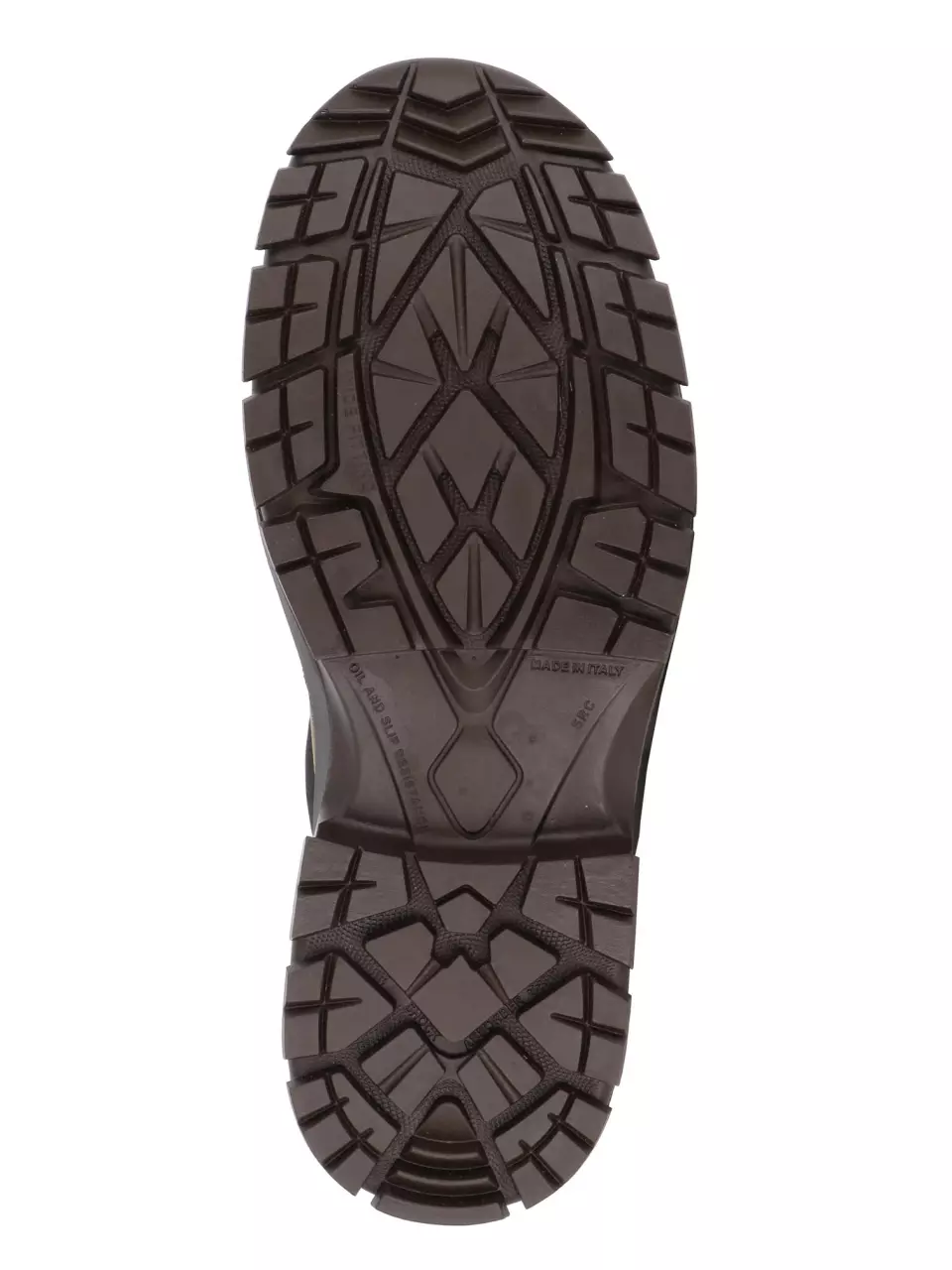Singer Safety High Safety Shoe, S3
SINGER Safety
visit storeProduct description
These high-cut safety shoes provide superior protection and comfort for demanding work environments. Featuring water-repellent nubuck leather construction with a composite shockproof toe cap and high-tenacity textile pierce-resistant midsole, they offer comprehensive foot protection while maintaining flexibility. The ergonomic design includes an E.F.P. tongue with gusset for enhanced comfort and a polyurethane double-density sole for excellent traction on various surfaces.
Product Features:
- High-cut water-repellent nubuck leather upper for durability and protection
- Composite shockproof toe cap (200J) for impact resistance without metal
- High tenacity textile pierce-resistant midsole (1100N)
- E.F.P. tongue with gusset for improved comfort
- Ergonomic preformed PU insole for all-day support
Technical Details:
- Textile lining for breathability
- Polyurethane double-density sole for shock absorption and traction
- Weight: 730 g per shoe (size 42)
- Antistatic properties for electrical safety
- Slip resistance (SRC rated) for secure footing
Recommended Applications:
- Public works
- Building and construction
- Finishing work
- Agriculture
- Green spaces maintenance
Standards:
- EN ISO 20345 S3 SRC certification
- European Regulation (EU) 2016/425 on PPE, Category II
- ISO 9001 / ISO 14001 certified production
EAN: 3660514235939, 3660514235953, 3660514235977, 3660514235991, 3660514236011, 3660514236035, 3660514236059, 3660514236073, 3660514236097
The material composition of the shoe's bottom portion that determines slip resistance, durability, and protection against workplace hazards like chemicals, heat, or punctures.
The method used to secure the shoe to your foot, affecting ease of putting on/removing, adjustability for comfort, and workplace safety.
Indicates whether the footwear has protective reinforcement (Safety) or no special toe protection (Plain), affecting workplace safety compliance and injury prevention.
Withstands degradation from oil exposure, maintaining sole integrity and extending shoe life. Ensures reliable traction in oily environments.
Enhances stability on slick surfaces, reducing the risk of slips and falls. Designed for reliable grip and secure footing in various work environments.
Reduces impact on feet and joints, lessening fatigue during long hours on hard surfaces. Provides enhanced comfort for demanding work environments.
Indicates the exterior color of safety footwear, helping you match workplace dress codes while considering visibility and practicality in your work environment.
The color of the shoe's bottom surface that affects visibility in low-light conditions, complements uniform requirements, and reflects personal style preferences.
Identifies the protective material in the toe cap that shields against impacts and compression. Different materials offer varying levels of protection, weight, and comfort.
- Slip Resistant
- Water Resistance
- Electrical Protection
- Impact Resistance
Request a free sample
Test first and buy later. Visit any product page to request your free sample.
Standards and labels
Test results
Service Reliability PassedEN ISO 9001:2015 is a globally recognized standard that specifies requirements for a quality management system (QMS), focusing on numerous aspects of quality management in organizations, aiming to enhance customer satisfaction through the effective application of the system. The 'Service Reliability' with a 'Passed' designation indicates that an organization has successfully demonstrated its ability to consistently provide services that meet customer and regulatory requirements while aiming for continual improvement. This assessment involves evaluating various elements of the QMS including service planning, execution, and monitoring, to ensure reliability and performance consistency. The practical implications for organizations that pass this aspect of the standard are significant; it establishes them as reliable providers in their industry, enhancing customer trust and satisfaction, and potentially leading to increased business and a competitive advantage.
Test results
General Requirements S3The EN ISO 20345:2011 standard specifies the general safety requirements for protective footwear used in various industries. The S3 designation under this standard means the footwear has met certain criteria, including basic toe protection, anti-static properties, energy absorption of the seat region, water resistance, fully enclosed heel, cleated outsole, and penetration resistance by a steel midsole. This classification involves specific test methods like compression and impact tests on toe protection, antistatic resistance tests, energy absorption verification at the heel section, water penetration, and absorption tests to ascertain the upper material's resistance, and penetration resistance tests to ensure the protective features of the outsole and midsole. For industries requiring protective footwear that can withstand mechanical risks, moisture, and sharp objects, achieving an S3 result guarantees a high safety level, making footwear that meets this requirement suitable for environments with increased moisture and at risk of foot penetration by sharp objects.
General Requirements CRThe standard EN ISO 20345:2011 encompasses general requirements for safety footwear to ensure they provide adequate protection in various occupational environments. Rating 'CR' signifies that the footwear has a cut resistant upper ensuring enhanced protection. The test method involves assessing the material's resistance to splitting or cracking under certain conditions, which simulates real-world industrial hazards involving sharp objects or surfaces. Practically, this result ensures that the footwear is suitable for environments where there is a risk of materials splitting or getting caught, thereby providing essential safety benefits to the user.
General Requirements WRUThe WRU result in the context of standard EN ISO 20345:2011 represents Water Resistant Upper, which indicates that the footwear possesses an upper resistant to water penetration, thereby providing a certain degree of waterproof protection to the wearer's feet. Fundamentally, the test determining this result involves subjecting the upper part of the footwear to a water penetration test under specified conditions of pressure and duration. This ensures that water does not penetrate through the outer surface into the footwear up to a minimal threshold. The practical implication of achieving the WRU result under the EN ISO 20345:2011 standard is that the footwear is suitable for work environments or activities where exposure to water or moisture is prevalent, ensuring durability and increased comfort for the wearer over an extended period of wet conditions. This qualification is particularly crucial for industries like construction, outdoor work, or any professions where workers might be exposed to water around their feet.
General Requirements AEN ISO 20345:2011 sets standards for safety footwear intended for professional use, ensuring that such footwear provides adequate protection according to specified safety requirements. Rating A means the footwear has antistatic proterties. The practical implication of an A rating result is that the footwear is certified as having met the necessary conditions for standard professional use, which can reassure procurement professionals of the product's basic safety compliance specific to an industrial or harsh working environment. Such comprehensive testing and certification mean that businesses can ensure worker safety and regulatory compliance when procuring such footwear.
General Requirements EThe standard EN ISO 20345:2011 encompasses general requirements for safety footwear to ensure they provide adequate protection in various occupational environments. The specification of test result E indicates that the footwear has undergone and successfully met the electrical insulation performance requirements. This specific test assesses footwear's ability to prevent electrical current from passing through the body from the ground, a critical safety feature for those working in environments with electrical hazards. The test involves placing the footwear on a conductive surface and measuring the resistance when a specified voltage is applied, thereby ensuring the footwear provides the necessary protection against electrical hazards. This result is significant for safety footwear, guaranteeing wearer protection in electrical environments and reducing the risk of electrocution, thus contributing to safety standards compliance for occupational footwear in the European market.
General Requirements PEN ISO 20345:2011 specifies safety requirements for footwear used in a range of industries to protect wearers from mechanical risks and other workplace hazards. The 'P' designation indicates that the footwear has been tested for penetration resistance, which means it can withstand a force of up to 1100 Newtons from sharp objects like nails. This test is conducted by applying a specified force to a nail or similar sharp object against the sole of the footwear to ensure it cannot penetrate through to the foot. Footwear meeting this requirement is essential for industries where workers are at risk of stepping on sharp objects, such as construction or manufacturing, providing a critical level of protection to the wearer's feet.
ISO 14001:2015 is a standard that specifies requirements for an environmental management system (EMS). It includes requirements for how companies should design, implement, maintain and improve their EMS to ensure that they minimize negative impacts on the environment and comply with environmental regulations. Test results can include information on how well the EMS is functioning, how well it is being followed, and how effective it is in reducing environmental impacts. The standard also includes requirements for how the company should document and record their EMS performance and continuously improve it.
Test results
Environmental Management PassedThe standard ISO 14001:2015 pertains to environmental management systems (EMS). A passed test result under this standard indicates that an organization's EMS meets the stringent criteria set forth for managing environmental responsibilities systematically. This ensures sustainable development while considering environmental impacts. Specifically, ISO 14001:2015 includes requirements for a framework that an organization can follow rather than establishing environmental performance criteria. It encompasses various aspects such as compliance obligations, planning actions to address risks and opportunities, and continual improvement. The test primarily involves evaluating the effectiveness of the EMS in supporting a company to achieve its intended outcomes regarding its environmental performance. If a company has passed this evaluation, it reflects their commitment to environmental stewardship, potentially enhancing their marketability and aiding in compliance with statutory and regulatory requirements.
Textiles are materials made from fibers, such as cotton, wool, or polyester. In Europe, there are rules for how textiles should be made, sold, and labeled. These rules are set by the European Union. These rules ensure that textiles are safe and do not contain harmful chemicals, that they are labeled correctly and that the use of certain dangerous chemicals are banned. These rules are set to protect the health and safety of consumers and the environment. Companies that make or sell textiles in the EU must comply with these rules.
PPE stands for "personal protective equipment." PPE Category 2 refers to equipment that is more complex, and has a higher level of risk. Examples of PPE Category 2 include safety helmets, ear protection, and fall arrest equipment. In Europe, PPE Category 2 must meet certain safety standards set by the European Union, which means that it must be designed and manufactured to protect the user without causing harm. Companies that make or sell PPE must prove that it meets these standards. They also must have a quality management system in place and have to be audited regularly by a notified body.
CE Marking is a label that shows a product meets certain safety and environmental standards set by the European Union. To get the CE Marking, a company must test and certify their product meets these standards. CE Marking is required for many products sold in the EU, including electronics, machinery, toys and medical devices. It helps ensure that products are safe for consumers and the environment, and allows for easy trade within the EU.
SINGER Safety delivery terms
Free delivery when you order more than 1 650,00 kr from SINGER Safety
Supplier shipping fee 60,00 kr
Brand minimum 2 000,00 kr
755,77 kr
Shipping fee is 60,00 kr for orders under 1 650,00 kr
Sold in units of one pair
Need larger quantities?
Other products you may like
Recently viewed
Need help?
Get help from our experts
Other products you may like
Similar products you may like
Recommended for you
SINGER Safety
Delivery time: 5 business days
Orders from 2 000,00 €
Supplier shipping fee 60,00 €
Free shipping on orders over 1 650,00 €



Find +150,000 products from hundreds of brands
Autonomous sourcing platform
The most efficient way to source and order supplies for your operations
Sourcing
Ordering
List products you’re looking for and we’ll find the best products and prices for you – all for free.
Need help?
Get help from our experts



